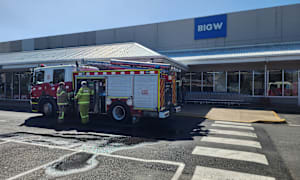THIRTEEN Strzelecki Group fire brigades had a busy Sunday preparing for the upcoming fire season, participating in training exercises around Leongatha.
As well as sharpening skills, it was a great mentoring opportunity, giving some members the chance to try new roles.
Sentinel-Times visited District 9’s Field Operations Vehicle (FOV), containing radios, computer equipment and a weather station that helps those manning the vehicle to predict fire behaviour and convey necessary information.
District 9 covers Baw Baw and South Gippsland Shires, Inverloch and Pound Creek.
Various scenarios were thrown at the participating brigades throughout the day, including ‘red flag warnings’ that indicated potentially dangerous changes in circumstances such as altering wind direction, and required decisive action to ensure the safety of crews.
Crews practised tackling a grass fire threatening an industrial area, those in the front fire truck having a moving target at which to aim, in this instance a towed tyre rather than flames, District 9 Commander Simon Bloink taking this scribe to see the action.
He stressed that just like the brigade volunteers getting ready for anticipated dangerous and dry conditions as summer approaches, members of the community should have up-to-date fire plans and tackle tasks such as clearing potential fuel loads from their properties.
Listening to Simon, it was clear the many considerations that go into fighting fires and the need for a thorough understanding of fire behaviour, giving a deeper appreciation of the commitment volunteers show.
He spoke of the elevated nature of the grass area in relation to nearby industrial faclities and a truck, pointing out the increased threat posed by radiant heat due to the proximity of the flames to the truck’s windows, threatening to ignite a fire in its cabin.
During the grassfire practice, Simon spoke about the varying ages of the fire trucks, between new and about 30 years old, and the changes in technology over time.
That included the ability to operate the pump from inside the cabin as opposed to the back of the truck and the differing ways in which crews monitor the quantity of water in their tankers, from old-style gauges to a modern approach using coloured lights.
Simon explained that truck crews never allow their water to run out completely, always retaining sufficient to operate their safety systems in case of incidents such as a burnover.
Unfortunately, weather didn’t play its part on Sunday, strong winds forcing the cancellation of a drone demonstration planned to highlight how the technology can be used in firefighting.
Drones can provide video, photos and thermal imaging.
After lunch at Leongatha Recreation Reserve, kindly served by members of the Narre Warren Fire Brigade, training participants heard about the many considerations for those in charge at fire scenes when it comes to managing support from heavy machinery operators.
A key message was that as an incident controller, you become responsible for that machinery.
That includes scenarios such as a farmer offering to operate his tractor to help brigades, with the incident controller needing to establish if the equipment is suitable for the purpose, and ensure it is not used otherwise.
The heavy machinery session took place next to a large excavator, and it was stressed that such machines have many blind spots and to never assume the operator has seen you.
The support of the community throughout the day, including those whose properties and streets the brigades visited, was much appreciated by those involved.










